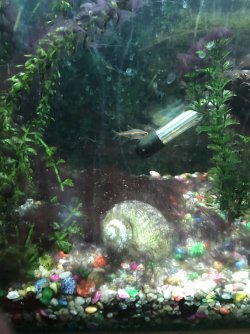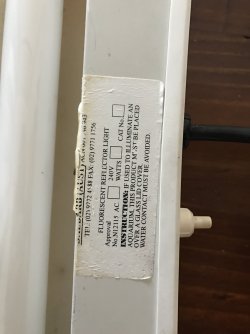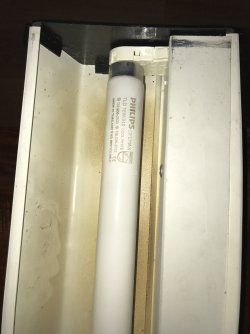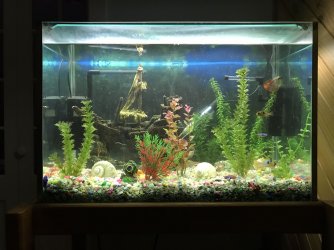I tracked down the present light you have, here [this link is the smaller tube, but doesn't matter as the important data is the same]
https://www.lampreplacements.com.au...PS-LifeMax-TLD-Tube-10w-T8-4100k-(330mm).aspx
and it is T8, so that is good (T5 would be way too bright and frequently the cause of algae in aquaria).
The spectrum (colour temperature, the Kelvin) is 4100K which is on the "warm" side but without live plants this is less of an issue. With Kelvin, the colour temperature (nothing to do with heat) of light is "warm" with lower numbers and "cool" with higher. The lower the number the more red and less blue, and the higher the number the more blue and less red. I know it is a bit confusing as this 4100K is termed "cool white" but that is only by comparison with their "warm white" which is even lower K.
Over aquaria, light around 6000K to 7000K is generally closest to mid-day sun. I see they have such a tube, here:
https://www.lampreplacements.com.au...PHILIPS-Alto-TL-D-Tube-18w-T8-6500k-(563-2mm)
When the time comes to replace the present, you might consider this one. It will give a truer rendition of fish and plant colours.
Speaking of replacement, the tube weakens as it burns, and will normally need replacing long before it actually burns out. This is more crucial with live plants, but still worth doing without plants. I am going to suggest live floating plants next, so I would replace the tube every 12 months. I do this on all my tanks.
Moving on to the algae issue. As I said previously, algae is normal especially without live plants, but it would be preferable to keep it more in check. There are a few ways to do this. First is with floating plants. I don't know what is available in the fake plant line, but you might try live floating plants. These are easiest to grow because they are close to the light, they can take up CO2 from the air which is easier for the plant, and they will readily take up nutrients from the water. This means the algae is being thwarted by less light and fewer nutrients. The fish will also benefit, as they do not appreciate overhead light and dimming it with floating plants is very natural. Few fish habitats see direct sun, having overhanging terrestrial vegetation or floating plants.
Reducing the light duration will help, but not as much as adding live floating plants. You can have the light on a timer, and schedule the on/off so it is on when you would normally be home to enjoy the aquarium. Fish don't need much light, and provided the day/night periods are regular each 24 hours, they will be fine. With the other changes, you could stay around 7-8 hours of light.
Increase the volume of your weekly water change, as I previously mentioned. Half the tank volume will go a long way to reducing organic nutrients feeding the algae. There will still be plenty for floating plants. And clean into the substrate, as you appear to be doing. That is where the organics collect, which is natural, and the many types of bacteria that live in the substrate are important to a healthy aquarium, but without live plants in the substrate there is no need to let these get to excess.
With this is a regular filter cleaning/rinsing. During the water change, remove both filters and rinse the media. Organics accumulate in the filter obviously, and these can impede water flow as well.
This should go a long way in keeping this algae at bay.
Byron.







